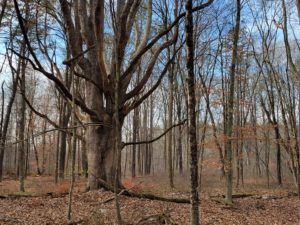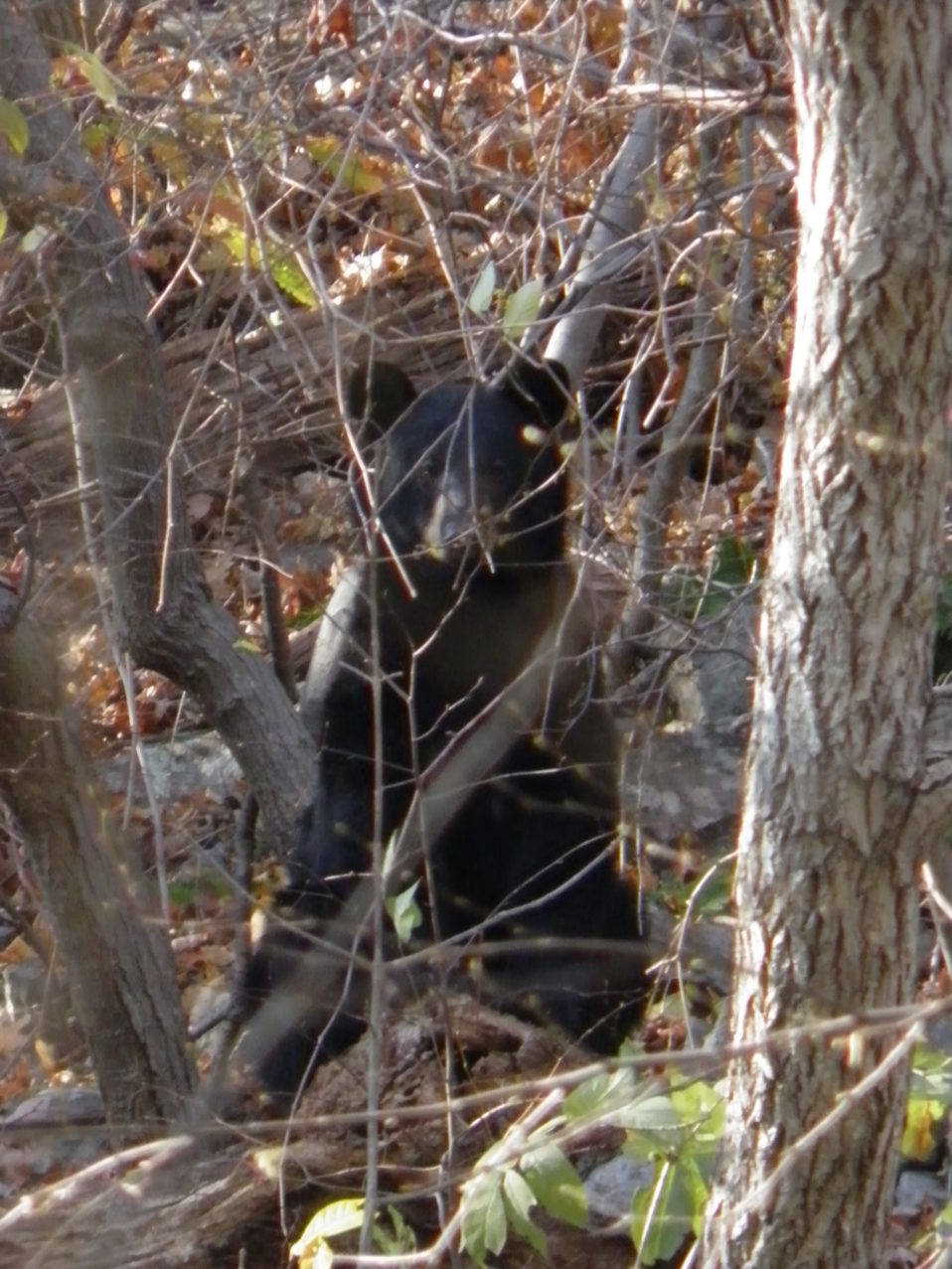
An lone remnant old oak at the edge of an old stone row (indicating the area was historically cleared most likely for agriculture) located in now an even-aged forest within the Flat Brook Wildlife Management Area. As indicated in numerous US Forest Service Forest Inventory Analysis (FIA) reports and as listed in the NJ Forest Action Plan, “The majority of New Jersey’s forests are of relatively uniform age distribution centered around the 61-80 year old age class as indicated by FIA data. Promoting and managing for various (forest) age classes across the landscape will help the state’s forests to remain resilient and more diverse.” (NJFAP, 2020). Photo by John Parke
In recent weeks, we discussed the concept of old growth forests and its application in New Jersey. We provided some examples from Davis (1993, 2003r) and recent observations and developments in those areas. We asked several questions. In this final installment, we attempt to tie it all together and speak to management implications.
Forest systems evolved to regenerate over time through natural disturbances. But humans have eliminated some disturbances (e.g. fire) and introduced or accelerated other stressors, including excessive deer herbivory, invasive species, and climate change. These changes have in turn caused a loss in structural heterogeneity and forest biodiversity (characteristics that are necessary for old-growth functionality).
As we have discussed in prior posts, of New Jersey’s possible old growth sites identified in Old Growth in the East (1993, rev 2003), none of these areas are pristine. All of these sites have been influenced by modern human activity and all continue to be threatened by a hands-off approach to management. These areas are experiencing ‘Proforestation’ (Moomaw et al., 2019), a concept that promotes “growing existing forests intact to their ecological potential” without further intentional management. However, as discussed previously, these forests have experienced past disturbance and are currently subject to stress from climate change, invasive species, and intense deer herbivory. What if focusing on carbon storage blinds us to factors that could increase the vulnerability of these forests to stressors over the next 20 or 50 years? What if those stressors drive large-scale, synchronous overstory mortality and a net loss in the carbon and biodiversity pool? Some articulations of the proforestation concept, seem to discount the dynamics experienced by forests through time and space as well as the importance of variability in stand structure to yield long-run stability over expansive forests.
Preserving sites across NJ and allowing for only passive management (reserves) is appropriate for some portions of the landscape, but blanket application of this approach does not guarantee that forests will develop into functional old growth, given the increasingly severe stressors that are impacting our forests. Forest stewardship planning and active management (where appropriate) also has an important role in sustaining forest biodiversity, health, and resilience to ensure that a portion of our forests can reach, and properly function as old-growth forests in the future.

A habitat restoration cut at Sparta Mountain Wildlife Management Area after 3 growing seasons. This restoration area is now providing structure and diversity components that are indicative of a forest heading toward an old-growth phase over time. Additionally, now that this area has a diverse age class of trees, more diverse species of trees and other native vegetation, it also provides critical habitat for numerous wildlife species, improved ecological services and forest resilience against climate change related threats over the long-term. Photo taken in 2017 by Don Donnelly
There are forest management techniques available that can be used to increase tree diameters and enhance other elements of structural complexity found in old growth. Through careful forest stewardship planning, forest managers can balance our forest age classes (Young, Mature and Old) on the landscape and mitigate the effects of forest stressors using proactive techniques to meet goals related to ecosystem health, forest resilience, carbon sequestration, and biodiversity. In fact, an ecosystem with high structural heterogeneity and biodiversity has been shown to be more resilient to human stressors by absorbing carbon dioxide and nitrogen better than forests with lower biodiversity (Moony, Cushman, Medina, Sala, & Schulze, 1996). Diverse forest ecosystems containing native plants and mixed age classes face lower risk of failure than a simplified system, because such complex communities have redundancies built into them (Peterson, Allen, & Holling, 1998). Thus, the simple preservation of old trees, does not automatically translate to a future with more old growth forests
NJ Audubon supports forest stewardship planning and implementation of active ecological forest management practices. For more information contact NJ Audubon at [email protected].
By Liz Matseur, John Parke, Don Donnelly and Alex Ireland, Ph.D
References:
Davis, M.D., 1993, Old Growth in the East: A Survey, Cenozoic Society, University of Wisconsin-Madison
Davis, M.D., 2003, Old Growth in the East: A Survey. Revised Edition, Appalachia-Science in the Public Interest on behalf of the Eastern Old-Growth Clearinghouse, Georgetown, KY, First edition: Copyright © 1993 by the Cenozoic Society
Fassnacht, K. S., D. R. Bronson, B. J. Palik, A. W. D’Amato, C. G. Lorimer, and K. J. Martin. 2015. Accelerating the development of old-growth characteristics in second-growth northern hardwoods. General Technical Report. NRS-144. Newtown Square, PA: U.S. Department of Agriculture, Forest Service, Northern Research Station. 33 p.
Mooney, H.A., Cushman, J.H., Medina, E., Sala, O.E. & Schulze, E.D. (1996). What we have learned about the ecosystem functioning of biodiversity. In H.A. Mooney (Ed.), Functional roles of biodiversity: A global perspective (pp.476-484). Hoboken, NJ: John Wiley.
Moomaw, W.R., S.A. Masino, and E.K. Faison, Intact forests in the United States: Proforestation mitigates climate change and serves the greatest good. Frontiers in Forests and Global Change, 2019. 2: p. 27.
New Jersey State Forest Action Plan, December 2020, New Jersey Department of Environmental Protection, Division of Parks and Forestry, NJ Forest Service
Trenton, NJ 08625
Peterson, G., Allen, C.R, & Holling, C.S. (1998). Ecological resilience, biodiversity, and scale. Ecosystems, 1(1),6-18.
















